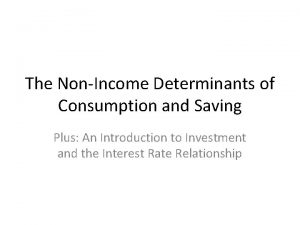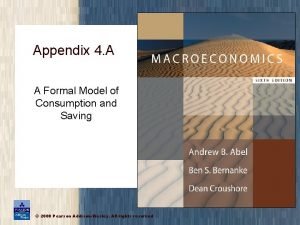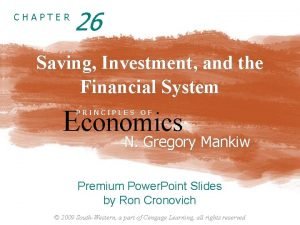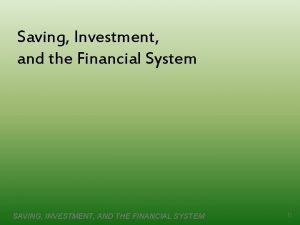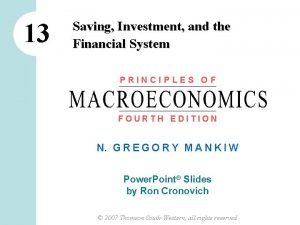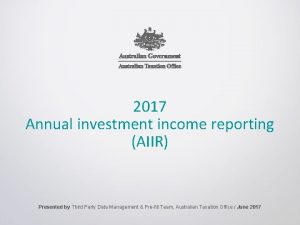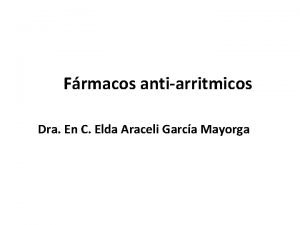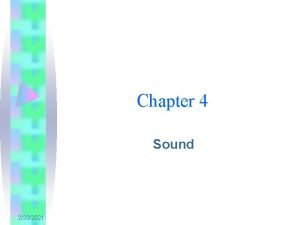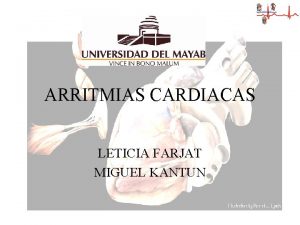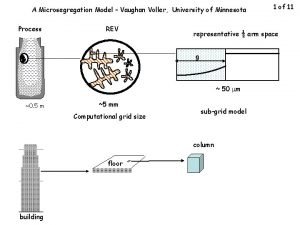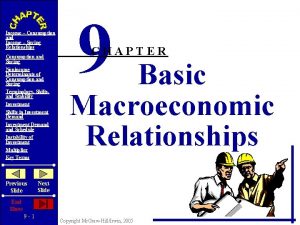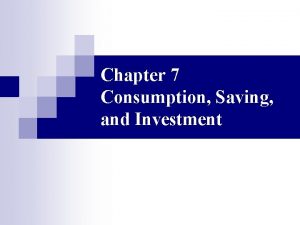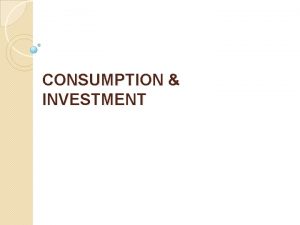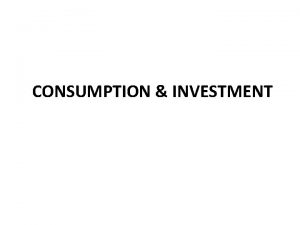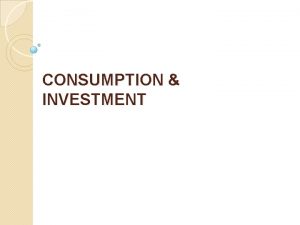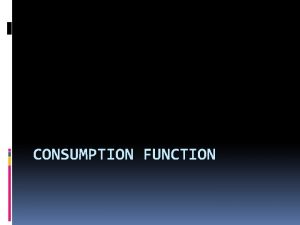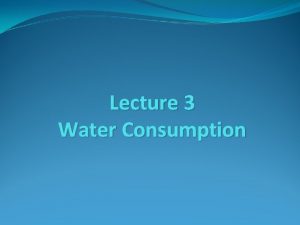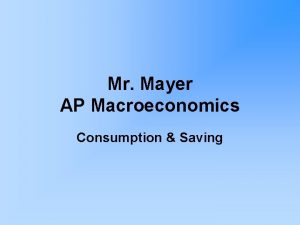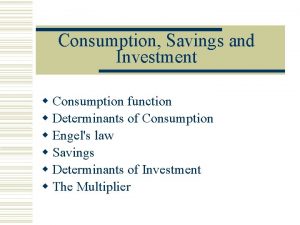Consumption Saving and Investment Mr Vaughan Income and





![Consumption and Saving Key Equation (two-year household budget constraint): C 1+[C 2/(1+i 1)] = Consumption and Saving Key Equation (two-year household budget constraint): C 1+[C 2/(1+i 1)] =](https://slidetodoc.com/presentation_image_h2/1248b00f686b9dabeabb68b34ce7a099/image-6.jpg)















- Slides: 21

Consumption, Saving, and Investment Mr. Vaughan Income and Employment Theory (402) 1

Lecture Goals • Use microeconomic building blocks to explore household choices of consumption/saving patterns. • Assumptions: – Household takes real wage as given (i. e. , labor market is perfectly competitive) – Household takes interest rate as given (i. e. , bond market is perfectly competitive) – Households choose a time path of consumption (C 1, C 2, C 3, etc. ) to maximize utility subject to a budget constraint. – Higher consumption in any year increases household utility. – Households prefer smooth consumption, even if income is irregular (i. e. , they prefer C 1, C 2, C 3, to relatively close together) 2

Consumption and Saving Recall, Household budget constraint: • C + (1/P)·∆B+ ∆K = π/P + (w/P)·L + i ·(B/P +K) • π /P = 0 • C + (1/P)·∆B+ ∆K = (w/P)·L + i·(B/P + K) (i. e. , consumption + real saving = real income) (6. 12) (7. 1) 3

Consumption and Saving Consumption over Two Years: § Year 1 C 1 + (B 1/P + K 1) − (B 0/ P + K 0) = (w/P)1·L + i 0·(B 0/P + K 0) (7. 2) (i. e. , real consumption in year 1 + real saving in year 1 = real income in year 1) § Year 2 C 2 + (B 2/P + K 2) − (B 1/P + K 1) = (w/P)2·L + i 1 · (B 1/P + K 1) (7. 3) (i. e. , real consumption in year 2 + real saving in year 2 = real income in year 2) § Now, combine budget constraints to describe household’s choice between consuming this year, C 1, and next year, C 2. – Notice both 7. 2 and 7. 3 include (B 1/P + K 1). So solve 7. 2 for (B 1/P + K 1) – So solving 7. 2 for (B 1/P + K 1), yields: B 1/P+K 1 = B 0/P+K 0 + [i 0·(B 0/P + K 0) + (w/P)1·L] - C 1 (7. 4) (i. e. , real assets end year 1 = real assets end year 0 + real income year 1 − consumption year 1) – Similarly, B 2/P+K 2 = B 1/P+K 1 + [i 1·(B 1/P + K 1) + (w/P)2·L] – C 2 (7. 5) (i. e. , real assets end year 2 = real assets end year 1 + real income year 2 − consumption year 2) 4

Consumption and Saving Consumption over Two Years: 1. Factoring out “(B 0/P + K 0)” on the right-hand side of 7. 4 leaves: B 1/P + K 1 = (1+i 0) · (B 0/P + K 0) + (w/P)1 · L − C 1 (7. 6) 2. Doing the same with “(B 1/P + K 1)” in 7. 5 leaves: B 2/P + K 2 = (1+i 1) · (B 1/P + K 1) + (w/P)2 · L − C 2 (7. 7) 3. Now, substituting 7. 6 into 7. 1 yields: B 2/P+K 2 = (1+i 1)·[(1+i 0)·(B 0/P+K 0)+(w/P)1·L - C 1] + (w/P)2·L − C 2 or B 2/P + K 2 = (1+i 1)·(1+i 0)·(B 0/P+K 0)+(1+i 1)·(w/P)1·L - (1+i 1)·C 1 + (w/P)2·L − C 2 (7. 8) 4. Dividing by (1+i 1) and collecting consumption terms on left-hand side yields… 5
![Consumption and Saving Key Equation twoyear household budget constraint C 1C 21i 1 Consumption and Saving Key Equation (two-year household budget constraint): C 1+[C 2/(1+i 1)] =](https://slidetodoc.com/presentation_image_h2/1248b00f686b9dabeabb68b34ce7a099/image-6.jpg)
Consumption and Saving Key Equation (two-year household budget constraint): C 1+[C 2/(1+i 1)] = (1+i 0)·(B 0/P+K 0)+(w/P)1·L + [(w/P)2·L]/(1+i 1) - (B 2/P+K 2)/(1+i 1) (7. 9) § In words: Present value of consumption = Value of initial assets + Present value of of wage incomes − Present value of assets end year 2 § Now, to simplify analysis algebraically, let: V = ( 1 + i 0)·(B 0/P+K 0) + (w/P)1·L + (w/P)2·L/(1+i 1) (7. 10) Present value of sources of funds = Value of initial assets + Present value of wage incomes § So, (7. 9) can be rewritten: C 1+[C 2/(1+i 1)] = V - (B 2/P+K 2)/(1+i 1) (7. 11) Present value of consumption = Present value of initial assets − Present value of assets end year 2 6

Consumption and Saving Choosing Consumption: Income Effects § To keep things simple, hold (B 2/P+K 2)/(1+ i 1) constant. § Suppose V, present value of sources of funds, rises due to an increase in initial assets (B 0/P + K 0) or wage incomes (w/P)1·L and (w/P)2·L. Since (B 2/P+K 2)/(1+ i 1) is held constant, total present value of consumption C 1 + C 2/(1 + i 1) must rise by V. § Households prefer consuming at similar levels across years so C 1 and C 2 will rise by similar amounts. § This response of consumption to increases in initial assets/wage incomes are called income effects. 7

Consumption and Saving Choosing Consumption: Inter-temporal Substitution Effects C 1 + C 2/(1+i 1) = V − (B 2/P+K 2)/(1+i 1) p. v. of consumption = p. v. of sources of funds − p. v. of assets end year 2 § Again, to keep things simple hold (B 2/P+K 2)/(1+ i 1) constant. § Higher i 1 provides greater reward for deferring consumption. Therefore, household responds to increase in i 1 by lowering C 1 and raising C 2. § Viewed another way, higher “i” induces households to save more today. § Response is called inter-temporal-substitution effect 8

Consumption and Saving Choosing Consumption: Income Effects from Δi 1 § Again, to keep things simple hold (B 2/P + K 2) / (1 + i 1) constant. § Recall, household budget constraint for year 2: C 2 + (B 2/P + K 2) − (B 1/P + K 1) = (w/P) 2·L + i 1·(B 1/P + K 1) (7. 3) § Income effect from Δi 1 is [i 1·(B 1/P + K 1)] – i 1(B 1/P) – i 1 K 1 § Income effect from change in interest rate, i 1(B 1/P) – For bondholder, income effect from increase in i 1 is positive. For bond issuer, income effect from increase in i 1 is negative. => For economy as a whole, lending/borrowing balances. – So income effect from term i 1·(B 1/P) is zero. § Income effect from change in interest rate (i 1 K 1) – Average household’s holding of claims on capital, K 1, exceeds zero. – i 1 K 1 (income effect from increase in i 1) is positive. 9

Consumption and Saving Income effect from change in interest rate § In aggregate, income effect from increase in i 1 consists of zero effect from i 1·(B 1/P) and positive effect from i 1 K 1. § Result: Full income effect from increase in i 1 is positive. 10

Consumption and Saving Combining Income and Substitution Effects: Effect of increase in current interest rate (i 1) on year 1 consumption (C 1) § Inter-temporal substitution effect motivates household to reduce consumption today (C 1 ↓). § Positive income effect motivates household to raise consumption today (C 1 ↑). § Overall impact on current consumption is ambiguous (C 1 ? ). 11

Consumption and Saving 12

Consumption and Saving Consumption Over Many Years § Relax simplifying assumption households cannot change present value of assets held at end of year 2 (i. e. , consider consumption over “n” years) § Consumption and income in future years. – Present value of lifetime consumption (“n” years) = C 1 + C 2/(1 + i 1) + C 3/[(1 + i 1)·(1 + i 2) ] + · · · – Present value of lifetime wage income (“n” years) = (w/P)1·L + (w/ P)2·L/(1+ i 1) + (w/P)2·L/[(1+i 1)·(1+i 2) ] + · · · – Present value of assets in nth year) = (Bn/P+Kn)/(1+i 1)·(1+i 2)·(1+i 3)… 13

Consumption and Saving Consumption Over Many Years § (Bn/P+Kn)/(1+i 1)·(1+i 2)·(1+i 3)… is effectively zero and can be dropped. § Multiyear budget constraint (key equation, 7. 12) C 1 + C 2/(1+i 1) + C 3/[(1+i 1)·(1+i 2) ] + · · · = (1+ i 0)·(B 0/P+K 0) + (w/P)1·L + (w/P)2·L/(1+ i 1) + (w/P)2·L/[(1+i 1)·(1+i 2) ] + · · · p. v. of lifetime consumption = value of initial assets + present value of lifetime wage income. § What is the point? – Multi-year budget constraint facilitates analysis of impact of temporary and permanent changes in income. 14

Consumption and Saving Consumption Over Many Years: Temporary change in income C 1 + C 2/(1+i 1) + C 3/[(1+i 1)·(1+i 2) ] + · · · = (1+ i 0)·(B 0/P+K 0) + (w/P)1·L + (w/P)2·L/(1+ i 1) + (w/P)2·L/[(1+i 1)·(1+i 2) ] + · · · p. v. of lifetime consumption = value of initial assets + present value of lifetime wage income. § Household responds to rise in (w/P)1·L by raising consumption by similar amounts in each year: C 1, C 2, C 3, and so on. § This response means consumption in any particular year, such as year 1, cannot increase very much. § Implication: If (w/P)1·L rises by one unit, C 1 increases by much less than one unit. § Put it another way, Propensity to Consume in year 1 from extra unit of year 1 income is small when extra income is temporary. 15

Consumption and Saving Consumption Over Many Years: Temporary change in income § If (w/P)1·L rises by one unit on right-hand side, C 1 rises by much less than one unit on left-hand side. § Year 1 real saving, (B 1/P + K 1) − (B 0/P + K 0), must rise by nearly one unit on left-hand side. § Implication: Propensity to Save in year 1 from extra unit of year 1 income is nearly one when extra income is temporary. 16

Consumption and Saving Consumption Over Many Years: Permanent Change in Income § (w/P)1·L, (w/P)2·L, (w/P)3·L, and so on each rise by one unit. § Households respond by increasing consumption by one unit in each year. § Implication: Propensity to consume from extra unit of year 1 income is high—close to one—when extra income is permanent. (Or, put another way, Propensity to Save in year 1 from extra unit of year 1 income is small when extra income is permanent. § Permanent-Income Hypothesis (Milton Friedman): Consumption depends on long-term average of incomes (permanent income) rather than current income. 17

Consumption, Saving, and Investment in Equilibrium • Determine aggregate quantities of consumption and saving. • Determine aggregate quantity of investment. 18

Consumption, Saving, and Investment in Equilibrium Budget Constraint – C + (1/P)·∆B+ ∆K = (w/P)·L + i·(B/P) + i. K • i = (R/P − δ ) – C+ (1/P)·∆B+ ∆K = (w/P)·L + i·(B/P) + (R/P) · K − δ K – B = 0 and ∆B = 0 19

Consumption, Saving, and Investment in Equilibrium • Budget Constraint – C+ ∆K = (w/P)·L + (R/P)·K − δ K • (w/P)·L + (R/P)·K = Y (Real GDP). – C + ∆K = Y − δ K – Consumption + net investment = real GDP − depreciation = real net domestic product 20

Consumption, Saving, and Investment in Equilibrium • Left-hand side of equation implies economy’s net investment, ∆K, is determined by households’ choices of consumption, C. • Given real net domestic product, one unit more of consumption, C, means one unit less of net investment, ∆K. • This choice of C determines ∆K 21
 Determinants of consumption
Determinants of consumption The life-cycle model of consumption and saving
The life-cycle model of consumption and saving Determinants of consumption
Determinants of consumption Mankiw chapter 26 solutions
Mankiw chapter 26 solutions Saving, investment, and the financial system
Saving, investment, and the financial system Saving investment and the financial system
Saving investment and the financial system Fixed investment and inventory investment
Fixed investment and inventory investment Aiir companion guide
Aiir companion guide National income formula
National income formula Carrying value formula
Carrying value formula Non operating income on income statement
Non operating income on income statement Deferred tax asset journal entry
Deferred tax asset journal entry Sustainability metrics software
Sustainability metrics software Clasificacion vaughan williams
Clasificacion vaughan williams Midi vs digital audio
Midi vs digital audio Clasificacion vaughan williams
Clasificacion vaughan williams Mary c vaughan temperance movement
Mary c vaughan temperance movement Classificazione vaughan williams
Classificazione vaughan williams Aakash bavishi
Aakash bavishi Dr alison vaughan
Dr alison vaughan Classificazione vaughan williams
Classificazione vaughan williams Vaughan voller
Vaughan voller
